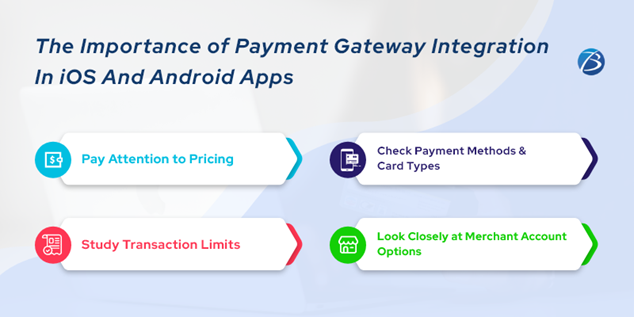The Importance of Payment Gateway Integration for iOS and Android Apps
Getting the right payment gateway integration in your online business will be a lot easier if you have the correct information and knowledge.

Do you carry cash everywhere or a smartphone?
Don't we all shop from our smartphones? Lately, mobile payments have gained prominence by providing a fast and easy way to make purchases and helping users save time and get an enhanced shopping experience.
How do we make the payment then? Of course, with the help of online payment options using payment gateways. Whether you talk about retail companies, ecommerce stores, freelancing platforms, travel agencies, they all are using payment gateways to help ease your payment.
Based on Statista’s website, by 2023, there will be around 1.31 billion proximity mobile payment transactions by users worldwide.
The payment gateway integration is not subject to one mobile OS; it's for both Android and iOS. These two OS’s have captured the entire global market, as we all know. Let's uncover the crucial aspects of integrating payment methods for both Android and iOS.

Let's start with;
What is a Payment Gateway?
Payment gateways are the median between online customers and financial institutions. Without intermediaries, in-app purchases and payment processes can't take place.
As we see, many apps like Amazon, Netflix, etc., ask for a subscription to watch shows, movies, etc. While paying for a subscription, it gets easy as, within a few steps, users can buy the subscription via the third-party app (Google Pay, PayPal).
The funds move through an interbank network, a complex sequence of operations and create risk associated with security assurance. It just takes users a few seconds, but it's a huge amount of work to deal with underneath the app.
Fortunately, banks take responsibility for all transactions and data safety, but how do you deliver this information to the bank? How will the application know that the customer has funds in his accounts and the account belongs to the customer?
Moreover, what about storing your payment details? What if all this information gets in the hands of the wrong people? Who is responsible for this? Both business owners and mobile app developers should not be the ones to bear this blame.
To get deep insights, let's now understand how a payment gateway works?

- Before opting for payment, users open a cart to buy the items they like. After doing so, they go to payment, wherein you have to enter debit or credit card details.
- The information you fill in is sent to a payment gateway system. It then encrypts user data and passes it to a payment processor.
- The payment processor is another mediator that begins the transaction process and gets feedback from the bank (Visa or Mastercard).
- The processor verifies the data accuracy and then transmits the information to the bank (financial institution), which has to finalize the verification (it takes seconds).
- After approval, the amount is withdrawn from the buyer's card and sent to the merchant's account.
Why Choose Payment Gateway Integration?
Considering the USA market, one can expect the USA digital payment market to register a CAGR (Compound Annual Growth Rate) of 12.14% over the forecast period from 2022 to 2025 (Source: Statista). Hence, it has become the most important aspect of any business.
The positive thing is that it allows collecting money through the customer's preferred bank without risking sensitive data.
With the increasing awareness about the ease of online transactions and digital evolvement, consumers are changing their priorities for making payments online. Hence it generates confidence among the users for switching to online transactions, which is why we see the boost in payment gateways.
Here we will see what the trend globally looks like:

In the year 2020, the size of the mobile payment market across the globe was valued at 1.54 trillion USD. This value rose to 1.97 trillion USD in 2021. The market has been predicted to grow at a CAGR of 29.1% from 2021 to 2028 and reach 11.83 trillion USD by 2028.

How to do the integration of payment gateway with iOS and Android?
- Install the app or any type of payment gateway based on your needs, such as the size of the business, industry or the targeted country.
- One should add client tokens when the server sends a request from your app. It helps generate a new token on every app launch with full authorization and configuration specifics to let the client initialize the SDK. One can execute it using various programming languages like JavaScript, React, NET, PHP, Python etc.
- Then the software developers will test the credentials such as customer id, public and private keys etc.
- It is important to install additional certifications that accept the PCI-DSS for better security. Further, the Secure Sockets Layer (SSL) guarantees clients' sensitive information protection.
- While processing a transaction, the one-time payment method needs to be configured. It works as: the client sends you card information, the gateways forward it to the server and uses that data to initiate the transaction.
How to Know the Best Applicable Payment Apps for You?

Firstly, make sure the payment gateway supports your product.
Many payment gateway providers support both digital and physical products. However, not everyone does that, plus some product groups are riskier, so the providers don't join in.
For example, Stripe has Restricted Businesses, including investment and credit services, gambling, adult content and services, get-rich-quick schemes, and many other categories.
Thus, you must be sure you're on the "white list" of a particular provider.
Pay Attention to Pricing
When it comes to payment gateway integration, keep in mind these fee types: monthly fee, gateway setup, merchant account setup, and per-transaction fee.
Dig through gateway documentation to ensure there are no hidden fee charges and the pricing policy is crystal clear.
Check Payment Methods and Card Types
You should always list payment tools and services used by your audience and make sure that a payment gateway of your choice supports all of them.
The integration of digital wallet payments differs from payment card support because of different tokenization processes. You must check if a payment gateway allows using mobile wallets.
Another essential point is that if you are targeting the international market, check the cost for businesses and multi-currency payments as some gateways require additional fees.
Study Transaction Limits
Payment gateways often have limitations for the numbers or amounts of transactions to take place. For example, Square's maximum transaction is 50,000 USD. This amount is enough for most businesses but may not be the same for you. Anything beyond this limit needs to be split into different instalments.
Look Closely at Merchant Account Options
A merchant account is an intermediary account where payments are parked before you get them, a kind of money storage. It is basically for a smooth shopping experience. At times buyers want to return the product or get a refund. To clear such issues easily, one can manage them with the money accumulated in your merchant account.
Well, when we talk about merchant accounts; then there are two types to know about:
First is a dedicated account that is for your business only. It helps you to control your money and operations. Companies with dedicated accounts usually receive faster transactions, but paying a higher price is also necessary to obtain the shortages.
The second is an aggregated account for several merchants (businesses). Mostly, entrepreneurs pick this option as it's cheaper and easier to set up (it takes less than 24 hours).
The Use Case: Square
Currently, three payment apps mostly applicable for payment gateway integration are Square, Stripe, and PayPal.
Square is the application that provides an all-round top choice for making payments in different ways (online, invoices, in-person, over the phone). It comes with many free features, a powerful POS app, and attractive equipment options.
Square acquired many companies, including Storehouse, Fastbite, and Kili. Major competitors for Square are Google Wallet (GOOGL), Intuit Inc. (INTU), and PayPal-owned (PYPL) Venmo.
Let's see what Square provided to a company named Kili (developed silicon, electronics, and software that simplify and optimize payment processing) after the acquisition.
While Square already offers a payment option to the users of credit cards via mobile, the Kili acquisition will let the company begin experimenting with Near Field Communication (NFC) payments (like Apple Pay). It will help compete with larger companies by delivering simple and affordable hardware that gives the sellers a safe and smart way to do business.
Conclusion
Does your company deal with any kind of online transaction? You need to allow payments in your mobile app. Using a payment gateway will give you a competitive advantage. The payment gateway is the connecting link between the bank and the customer and removes the hassles associated with safe data storage, transaction security and fraud detection.
Want to build an app that requires online payment gateway integration and looking for a mobile app development company to help you? Contact us today.